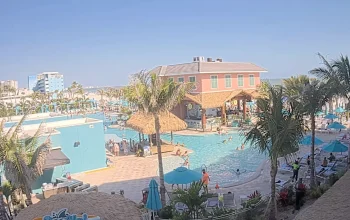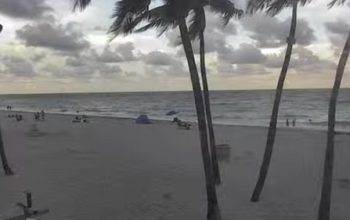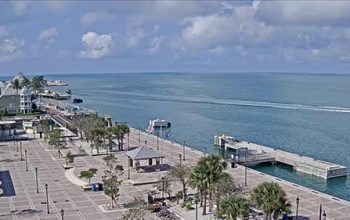New Smyrna Beach Cam
Birds-Eye View
South Beach

New Smyrna Beach Webcam: A Comprehensive Exploration
New Smyrna Beach is a hidden gem on Florida’s Atlantic Coast. Known for its beautiful beaches, vibrant community, and rich history, the town offers a blend of relaxation and adventure. Thanks to the New Smyrna Beach webcam, people from around the globe can enjoy the town’s charm in real time. Let’s explore the stunning views, the history, things to do, climate, geography, and the industries that thrive in New Smyrna Beach.
The New Smyrna Beach Cam provides breathtaking, real-time views of the town’s 17 miles of white sand beaches. The crystal-clear waters of the Atlantic Ocean shimmer under the sunlight, creating a picture-perfect coastal scene.
New Smyrna Beach is a famous surfing destination, and you’ll see people of all skill levels enjoying the swells. Families play along the shoreline, while others relax under umbrellas or explore the tide pools. The energy of the beach is contagious, even through a screen.
This virtual connection allows viewers to experience the lively atmosphere from anywhere in the world. Locals use the live camera to check the weather and wave conditions, while potential visitors use it to plan their trips. The views are a constant reminder of why New Smyrna Beach is a beloved destination.
Things to Do in New Smyrna Beach
New Smyrna Beach, Florida, is more than just a charming coastal town. Located on Florida’s east coast, this laid-back destination offers the perfect blend of sun, surf, creativity, and culture. With 17 miles of soft white sand, rich history, and a thriving arts community, there’s something for everyone to enjoy. Whether you’re visiting for a weekend or planning a longer stay, New Smyrna Beach has plenty to explore.
Seventeen Miles of Sandy Bliss
The heart of New Smyrna Beach is, of course, the beach itself. With miles of shoreline, visitors can swim, sunbathe, or stroll along the coast. You can even drive your car on certain parts of the beach. Early mornings are perfect for peaceful walks, while evenings offer some of the best sunset views.
Surfers love New Smyrna Beach. It’s often ranked as one of the best surf spots in the U.S. Whether you’re a seasoned pro or a beginner, there are surf schools and rental shops to help you ride the waves.
Enjoy Laid-back Adventures
New Smyrna Beach has several scenic boardwalks perfect for leisurely strolls. The Smyrna Dunes Park boardwalk, for example, stretches across dunes and offers stunning views of the Atlantic Ocean, Indian River, and Ponce Inlet Lighthouse.
Nature lovers will find a haven here. From dolphins in the surf to birds in the dunes, wildlife is everywhere. Bring your camera and binoculars—you never know what you’ll spot.
Visit The Hub on Canal
Located in the heart of downtown, The Hub on Canal is an inspiring space where local artists create, exhibit, and teach. The building itself is historic, and the art is modern and lively. With over 80 working artists, there’s always something new to see.
Take an Art Class or Workshop
Feeling creative? The Hub on Canal offers more than 20 weekly classes and dozens of workshops. Try your hand at painting, photography, or even jewelry-making. It’s a great way to learn something new and meet locals.
Atlantic Center for the Arts
This center brings together world-renowned artists and emerging talents. Located in a beautiful setting near the Indian River, it’s a peaceful spot for creativity. Stop by for exhibitions, concerts, and special events.
The Little Theatre of New Smyrna Beach
Founded in 1947, the Little Theatre is a community gem. It produces eight mainstage shows each season and an extra summer production. With a 250-seat venue, audiences enjoy intimate performances—from comedies to dramas to musicals.
Join the Experience
All actors, directors, and crew members are volunteers, making the theater feel like a big family. Attending a show here supports local talent and guarantees a fun night out.
Dive Into the History
New Smyrna Museum of History
This museum showcases the rich and varied past of the area. Exhibits cover everything from Native American history and early settlers to the area’s surfing heritage. It’s a great stop for families and history buffs alike.
Take a Guided Tour
The museum also offers guided walking tours of historic downtown. Learn about the Turnbull Colonists, the sugar mill ruins, and how the railroad shaped the city. Tours add depth to your visit and bring the stories of the past to life.
Explore Historic Sites
Old Fort Park
This mysterious coquina structure is often referred to as the “Old Fort,” although its original purpose is still debated. It’s surrounded by lush trees and offers a peaceful setting to reflect on the area’s colonial roots.
Sugar Mill Ruins
Just a short drive from downtown, the Sugar Mill Ruins are the remains of a 19th-century sugar factory. Massive stone walls and machinery still stand, giving a glimpse into Florida’s agricultural history.
Stroll Flagler Avenue
Shop and Dine
Flagler Avenue is the city’s most popular street. Lined with boutiques, gift shops, surf stores, and cozy restaurants, it’s a lively place to explore. Grab a cup of coffee, try some local seafood, or find a unique souvenir.
Enjoy the Nightlife
As the sun sets, Flagler Avenue comes alive. From beach bars with live music to rooftop lounges, there’s always a place to kick back and enjoy the evening.
Art and Culture Events
New Smyrna Beach hosts several festivals each year. The IMAGES: A Festival of the Arts attracts top artists from across the country. The Seaside Fiesta and Jazz Festival bring music and fun to the streets. These events celebrate the creative spirit of the community.
Family-Friendly Fun
There are also plenty of events for families. Enjoy parades, food trucks, kids’ zones, and more. It’s a great way to experience the local vibe and make new memories.
Explore the Outdoors
Kayak the Indian River
Rent a kayak or paddleboard and explore the calm waters of the Indian River Lagoon. The area is full of mangroves, manatees, and birdlife. Guided tours are available for beginners.
Fish from the Pier
The New Smyrna Beach Fishing Pier is a favorite spot for anglers. Cast a line and see what bites, or just walk the pier and enjoy the ocean breeze.
Bike the Trails
New Smyrna Beach is bike-friendly. The New Smyrna Beach Multi-Use Trail offers a smooth path through beautiful natural areas. Rent a bike downtown and go exploring.
The History of New Smyrna Beach
Long before Europeans arrived, the land now known as New Smyrna Beach was home to Native Americans. The Timucua people were the dominant group in this region. They lived in small villages along the Indian River and the Atlantic coast. Using the rich natural resources around them, they fished, hunted, and gathered shellfish. Their culture was deeply tied to the water and land.
Archaeological discoveries, like shell mounds and pottery shards, offer glimpses into their way of life. These artifacts show that the Timucua had a complex society with trade routes stretching across Florida. However, their population declined rapidly after European contact, mainly due to diseases and conflict.
Spanish Exploration
The first European explorers to reach the area were Spanish. In the early 1500s, they began mapping Florida’s east coast. However, they did not settle in what is now New Smyrna Beach. Instead, they established missions and forts further north. For centuries, the area remained mostly untouched by European colonists.
Dr. Andrew Turnbull’s Grand Experiment
In 1768, Dr. Andrew Turnbull, a Scottish physician, founded the colony of New Smyrna. At the time, Florida was under British rule. Turnbull had married a woman of Greek descent from Smyrna, in modern-day Turkey. He named the settlement “New Smyrna” in her honor and in recognition of the Greek laborers he planned to bring with him.
Turnbull launched one of the largest colonial ventures in North American history. He recruited about 1,300 settlers from the Mediterranean. Most were from Menorca, one of Spain’s Balearic Islands. Others came from Greece and Italy. These settlers were brought to work plantations that would grow crops like sugarcane, indigo, and hemp.
A Harsh Reality
Life in the colony was much harder than expected. Disease spread quickly in the swamps. Native raids and poor living conditions took a heavy toll. Tensions also grew between Turnbull’s overseers and the settlers. Many felt mistreated and overworked.
Though the colony saw some early success, especially in producing indigo, it didn’t last. By 1777, only about 600 settlers remained. They left the colony and walked nearly 70 miles north to St. Augustine. There, they found safety and a new home. Their descendants, known as the Minorcans, still live in St. Augustine today.
Return to Spanish Rule
In 1783, Britain returned Florida to Spain after the American Revolutionary War. Turnbull abandoned his efforts and retired to Charleston. Under Spanish rule, New Smyrna fell into decline. The area remained quiet, with only a few scattered settlers. Native groups, especially the Seminoles, still lived and moved through the land, defending their territory as white settlement slowly increased.
Turbulent Times and Conflict
Seminole Resistance
During the 1800s, tensions grew between the U.S. government and the Seminoles. The Seminole Wars began, bringing violence to central Florida. New Smyrna and surrounding areas were caught in the conflict. U.S. troops were stationed nearby to push Native people further south.
Civil War Skirmishes
Florida joined the Confederacy during the Civil War. On March 23, 1862, Confederate forces from the 3rd Florida Infantry Regiment clashed with a small Union landing party near New Smyrna. In 1863, Union gunboats shelled the town’s Stone Wharf. These events brought the war’s destruction to the quiet coastal settlement.
A New Era of Growth
Incorporation and the Railroad
By 1887, New Smyrna was incorporated as a town with a small population of just 150 people. The town’s fortunes changed in 1892 when Henry Flagler’s Florida East Coast Railway reached the area. The railroad connected New Smyrna to the rest of the state and the country. Tourists started arriving. The fishing and citrus industries also grew, fueling local development.
Prohibition and Smuggling
The 1920s brought Prohibition—and with it, secret trade. New Smyrna Beach and its nearby inlets became hotspots for rum-runners. Smugglers moved liquor from the Bahamas through Mosquito Inlet, now called Ponce de León Inlet. Hidden moonshine stills operated deep in the woods, making the town an active player in the underground liquor trade.
A Merged Beach Town
In 1947, the city of New Smyrna merged with the seaside community of Coronado Beach. The new name became New Smyrna Beach. Over time, the town evolved into a popular resort destination. Its historic charm, beautiful beaches, and vibrant art scene attract thousands each year.
Flags Over New Smyrna Beach
New Smyrna Beach has flown four flags in its history. These include the British flag under Dr. Turnbull, the Spanish flag after 1783, the Confederate flag during the Civil War, and the U.S. flag after Florida rejoined the Union in 1865. Each flag reflects a chapter in the town’s layered past.
Preserving the Past
Today, New Smyrna Beach honors its history through museums, historic sites, and festivals. The New Smyrna Museum of History tells the story of the Native peoples, the Minorcan settlers, and the city’s growth. Visitors can explore Old Fort Park, Sugar Mill Ruins, and even the remains of Turnbull’s original colony.
New Smyrna Beach isn’t just a beach town. It’s a place where the past still echoes through every shell-strewn path and historic corner. From the Timucua to Turnbull, from railroads to rum-runners, its story is one of endurance, culture, and change.
Where New Smyrna Beach Is Located
New Smyrna Beach sits on Florida’s east coast. The city’s exact coordinates are 29°01′33″N and 80°55′37″W. It belongs to Volusia County and covers a total area of 41.35 square miles. Out of that, nearly 38 square miles are land, while about 3.5 square miles are water. Waterways and coastlines play a big role in shaping this beachside town.
The Atlantic Ocean lies to the east, offering sweeping coastal views and a long stretch of sandy beach. On the western side of the city, the Indian River Lagoon flows parallel to the ocean, creating rich habitats for wildlife and calm spots for boating and fishing.
Surrounding Areas and Transportation
To the northwest, New Smyrna Beach touches the city of Port Orange. Unincorporated Volusia County borders it to the north. To the west, you’ll find the census-designated place of Samsula-Spruce Creek. To the south lie the cities of Edgewater and Bethune Beach, as well as the scenic Canaveral National Seashore.
Getting around is easy. Major roads like Interstate 95, U.S. Route 1, and State Road 44 connect New Smyrna Beach to other parts of Florida. These highways provide quick access to cities like Daytona Beach, Orlando, and even Miami.
Land and Water Features
New Smyrna Beach offers a diverse mix of landscapes. You’ll find coastal dunes, sandy beaches, tidal marshes, and dense oak hammocks. The city’s unique setting between the ocean and river makes it rich in both beauty and biodiversity. The Intracoastal Waterway also runs through the city, making it a hub for boating and water sports.
Barrier islands, like the one home to the seaside community of Coronado Beach, protect the inland from ocean swells. The Canaveral National Seashore, just south of the city, preserves large sections of Florida’s natural coastline, offering miles of undeveloped beach and protected wildlife habitats.
Understanding New Smyrna Beach Climate
A Humid Subtropical Zone
New Smyrna Beach has a humid subtropical climate. This means long, hot summers and mild, dry winters. According to the Köppen climate classification, this type of weather is marked as “Cfa.” Like most of northern and central Florida, the city experiences high humidity from late spring through early fall.
Seasons in New Smyrna Beach
The rainy season runs from May through October. During this time, short but heavy thunderstorms are common, especially in the afternoons. These storms often come with strong winds, loud thunder, and lightning. In fact, central Florida is considered the lightning capital of North America.
The dry season spans from November through April. During these months, the weather is sunny and pleasant, with low humidity and comfortable temperatures. Winters are especially enjoyable, attracting seasonal residents and tourists alike.
Rare Cold and Snow Events
Freezing temperatures are uncommon in New Smyrna Beach. The city averages only about two freezes per year. Because of the mild winters, tropical and subtropical plants like palms, hibiscus, and bougainvillea thrive in the area. Snowfall is almost unheard of. In over 250 years of recorded history, snow has been seen only three times.
Storms and Hurricanes
New Smyrna Beach, like much of Florida, is vulnerable to hurricanes. The official hurricane season runs from June to November. Although direct hurricane hits are rare, they do occur.
In 2004, Hurricane Charley passed directly over New Smyrna Beach after entering the state near Punta Gorda. It caused major damage to beachside areas and toppled many old oak trees in the historic downtown. More recently, Hurricane Ian in 2022 brought significant flooding and resulted in one fatality. Then in 2024, Hurricane Milton hit the area again. Nearly 90% of the city lost power, and widespread flooding occurred.
Living with Weather Risks
Because of these risks, residents prepare well during storm season. Homes often have storm shutters, and emergency plans are common. City officials also maintain flood management systems and issue alerts during severe weather events.
Why the Geography and Climate Matter
New Smyrna Beach’s geography and climate shape daily life in many ways. The beautiful landscapes draw nature lovers, beachgoers, and retirees. The warm weather supports a year-round outdoor lifestyle. But with these benefits come challenges, especially during hurricane season.
Understanding the local environment helps residents and visitors enjoy everything the city offers—while staying safe when the weather turns rough. With its mix of natural beauty and coastal resilience, New Smyrna Beach stands out as a unique gem on Florida’s Atlantic coast.


